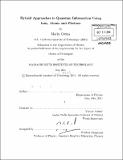| dc.contributor.advisor | Vladan Vuletić. | en_US |
| dc.contributor.author | Cetina, Marko, Ph. D. Massachusetts Institute of Technology | en_US |
| dc.contributor.other | Massachusetts Institute of Technology. Dept. of Physics. | en_US |
| dc.date.accessioned | 2012-01-30T16:56:13Z | |
| dc.date.available | 2012-01-30T16:56:13Z | |
| dc.date.copyright | 2011 | en_US |
| dc.date.issued | 2011 | en_US |
| dc.identifier.uri | http://hdl.handle.net/1721.1/68869 | |
| dc.description | Thesis (Ph. D.)--Massachusetts Institute of Technology, Dept. of Physics, 2011. | en_US |
| dc.description | Cataloged from PDF version of thesis. | en_US |
| dc.description | Includes bibliographical references (p. 235-250). | en_US |
| dc.description.abstract | This thesis presents two hybrid systems for quantum information processing - one joining cold ions and cold atoms and another coupling linear chains of atomic ions with photons via an optical resonator. The first experimental realization of a hybrid cold-ion / cold-atom system is presented in the form of Yb atoms trapped in a magneto-optical trap overlapped with Yb+ ions stored in a radio-frequency (RF) planar Paul trap. The overlap between the excited MOT atoms and the ion trap is used to obtain isotope-selective ion trap loading rates 104 times higher than previously achieved. The interaction between atoms and ions is measured by observing near-resonant charge-exchange collisions between Yb and Yb+ with a collision rate matching the classical Langevin cross-section. Momentum transfer between cold atoms and cold ions is observed via collisions of Yb+ ions with laser-cooled Rb atoms and a classical limit to the ion-atom collision energy in RF traps derived, with relevance to current ion experiments. The second part of the thesis presents the first integration of a scalable, microfabricated surface ion trap chip with an optical resonator. This chip trap is used to produce a linear array of ion traps and load these traps with isotopically-selected chains of Yb+ ions. The ion chains are overlapped with the mode of an optical resonator and the coupling of the individual ions to the resonator mode demonstrated by recording the frequency spectrum of the ions' near-resonance fluorescence. These measurements demonstrate the capability of the present system to store and process quantum information stored in short ion chains and to communicate this information via photons, with applications to large-scale trapped ion quantum information processing. The strong-near resonant optical field available inside the optical resonator may also be used to produce a periodic optical potential for trapped ions, with applications to quantum simulation. | en_US |
| dc.description.statementofresponsibility | by Marko Cetina. | en_US |
| dc.format.extent | 250 p. | en_US |
| dc.language.iso | eng | en_US |
| dc.publisher | Massachusetts Institute of Technology | en_US |
| dc.rights | M.I.T. theses are protected by
copyright. They may be viewed from this source for any purpose, but
reproduction or distribution in any format is prohibited without written
permission. See provided URL for inquiries about permission. | en_US |
| dc.rights.uri | http://dspace.mit.edu/handle/1721.1/7582 | en_US |
| dc.subject | Physics. | en_US |
| dc.title | Hybrid approaches to quantum information using ions, atoms and photons | en_US |
| dc.type | Thesis | en_US |
| dc.description.degree | Ph.D. | en_US |
| dc.contributor.department | Massachusetts Institute of Technology. Department of Physics | |
| dc.identifier.oclc | 773207913 | en_US |
